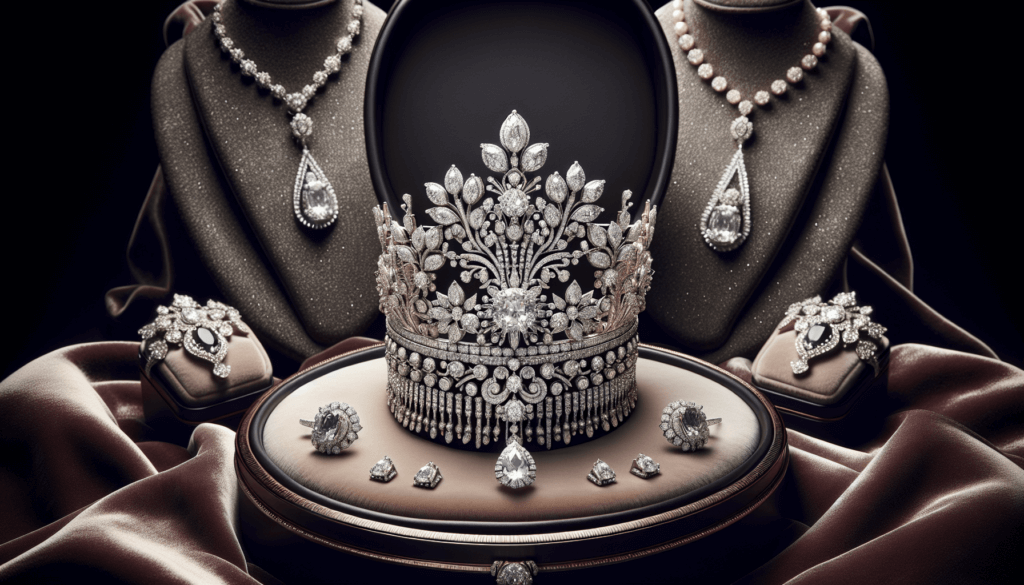Are you searching for the ultimate symbol of opulence and elegance? Look no further, for we have the answer to your burning question: what is the No 1 luxury jewelry brand? In a world where countless brands compete to capture your attention, there is one that effortlessly outshines the rest. With its unmistakable craftsmanship, timeless designs, and unparalleled reputation, this brand has secured its position at the very top of the luxury jewelry hierarchy. So, prepare to be dazzled as we reveal the name behind the coveted title of the No 1 luxury jewelry brand. The No 1 luxury jewelry brand is Cartier. With its rich history, impeccable craftsmanship, and influential designs, Cartier has solidified its position as the top brand in the industry. From its exclusive collections to its commitment to customer satisfaction, Cartier continues to set the standard for luxury jewelry worldwide. In this article, we will delve into the world of luxury jewelry, explore the criteria for luxury jewelry brands, and understand the demand for these exquisite pieces. We will then focus on Cartier’s journey to becoming the No 1 luxury jewelry brand, analyzing its success and impact on the industry. We will also take a closer look at Cartier’s competitors, examine the role of luxury jewelry in fashion trends, and discuss sustainability and ethical concerns within the industry. Finally, we will explore the investment potential of luxury jewelry, discuss the future of the industry, and offer a critical assessment of Cartier’s position as the top luxury jewelry brand.

Understanding Luxury Jewelry
Luxury jewelry is a category of high-end jewelry that exemplifies exceptional quality, design, and craftsmanship. It is characterized by the use of precious metals, gemstones, and intricate detailing. Luxury jewelry brands often cater to an affluent clientele who value exclusivity and aesthetic appeal. These brands are known for their attention to detail, meticulous craftsmanship, and exceptional after-sales service. Luxury jewelry pieces are considered timeless investments and are often passed through generations as cherished heirlooms.
Criteria for luxury jewelry brands include factors such as brand heritage, reputation, quality of materials used, and exclusivity. These brands have a long-standing history in the industry and have earned the trust and loyalty of their customers. They offer products that reflect exceptional craftsmanship and attention to detail. The design of luxury jewelry is often unique and innovative, distinguishing it from mass-market jewelry. Additionally, luxury jewelry brands maintain high standards of customer service and create a memorable buying experience for their clientele.
The history and significance of luxury jewelry dates back centuries. Throughout history, jewelry has served as a symbol of wealth, power, and status. It has been worn by royalty, nobility, and wealthy individuals to showcase their social standing and to adorn themselves with beauty. Luxury jewelry has been treasured for its aesthetic appeal and as a form of investment. Today, luxury jewelry continues to hold cultural and emotional significance, representing luxury, elegance, and sophistication.
Understanding the demand for luxury jewelry requires an understanding of the desires and aspirations of affluent consumers. Luxury jewelry appeals to those who seek exclusivity, exceptional quality, and impeccable design. It represents a symbol of status and wealth, making it desirable among the affluent elite. Luxury jewelry is often purchased for special occasions such as weddings, anniversaries, and milestone celebrations. Additionally, the emotional value attached to luxury jewelry makes it a sought-after gift for loved ones. The demand for luxury jewelry is driven by a combination of craftsmanship, aesthetic appeal, and the desire for a tangible investment.
The No 1 Luxury Jewelry Brand: Cartier
Brief history of Cartier:
Cartier, founded in 1847 by Louis-François Cartier in Paris, France, began as a humble jewelry store. Cartier quickly gained popularity among the French aristocracy for its exquisite craftsmanship and unique designs. By the early 20th century, Cartier had expanded its reach into international markets, catering to royalty and celebrities. Over the years, Cartier has continued to innovate and create timeless pieces that have become iconic symbols of luxury.
Present day status and influence of Cartier:
Cartier’s influence in the luxury jewelry industry cannot be overstated. The brand has established itself as a timeless symbol of elegance and sophistication. Its reputation for exceptional design and craftsmanship has earned it a loyal following around the world. Today, Cartier continues to thrive as a global leader in luxury jewelry, with boutiques in major cities and a strong online presence. Its influence can be seen in red carpet events, where celebrities proudly wear Cartier pieces, and in the countless fans who covet their iconic designs.
Most popular collections and products from Cartier:
Cartier is known for its iconic collections that have become synonymous with luxury. The Love collection, featuring the iconic “Love” bracelets and rings, symbolizes eternal love and commitment. The Panthère de Cartier collection showcases the brand’s affinity for sleek panther-inspired designs. The Juste un Clou collection features bold and edgy nail-inspired designs that have captivated fashion enthusiasts. Other notable collections include the Trinity collection, the Ballon Bleu de Cartier collection, and the Santos de Cartier collection. Each collection represents Cartier’s commitment to timeless elegance and innovative design.
Celebrities and notable figures who endorse or wear Cartier:
Cartier’s influence in popular culture can be seen through the numerous celebrities and notable figures who proudly wear their pieces. Hollywood stars such as Angelina Jolie, Kate Winslet, and Scarlett Johansson have been spotted wearing Cartier jewelry on the red carpet. Royalty, including Meghan Markle and Queen Elizabeth II, have also been known to wear Cartier creations. Cartier’s iconic designs have become a symbol of elegance and status, making them a favorite among celebrities and influential individuals.

Analyzing Cartier’s Success
Quality of Cartier’s jewelry:
One of the key factors behind Cartier’s success is its unwavering commitment to exceptional quality. Cartier sources the finest materials and utilizes meticulous craftsmanship to create jewelry pieces that stand the test of time. Each piece is meticulously inspected to ensure that it meets Cartier’s rigorous standards. By focusing on quality, Cartier has built a reputation for producing jewelry that is not only beautiful but also durable and long-lasting.
Exclusive designs and craftsmanship of Cartier:
Cartier is renowned for its distinctive and exclusive designs. The brand’s skilled artisans and designers continuously push boundaries, creating pieces that are innovative and captivating. Cartier’s dedication to craftsmanship is evident in every detail, from the precision of the settings to the carefully chosen gemstones. The brand’s unique designs have become iconic, instantly recognizable as Cartier creations.
Global presence and reach of Cartier:
Cartier’s success can also be attributed to its extensive global presence. With boutiques in major cities around the world, Cartier has established a strong foothold in the luxury jewelry market. The brand’s presence in prestigious locations further reinforces its reputation as a leader in the industry. In addition to physical stores, Cartier has a robust online presence, allowing customers from all corners of the globe to access their exquisite creations.
Customer service and experience provided by Cartier:
Cartier understands the importance of providing exceptional customer service and creating a memorable buying experience. From the moment a customer enters a Cartier boutique, they are greeted by knowledgeable and attentive staff who guide them through their journey. Cartier’s commitment to customer satisfaction extends beyond the point of sale, with comprehensive after-sales service and support. The brand’s dedication to customer service contributes to its strong reputation and customer loyalty.
Competitors of Cartier
Emerging luxury jewelry brands:
While Cartier holds the position of the No 1 luxury jewelry brand, it faces competition from other high-end jewelry brands. In recent years, several emerging luxury jewelry brands have gained recognition for their exquisite designs and craftsmanship. These brands offer a fresh take on luxury jewelry, appealing to a younger demographic with their contemporary designs and unique aesthetics. While they may still be building their brand legacies, their high-quality offerings pose a potential threat to established players like Cartier.
Market share and influence of competitors:
While Cartier dominates the luxury jewelry industry, its competitors hold notable market share and influence. Brands such as Tiffany & Co., Harry Winston, Bulgari, and Chopard have carved out their own niches within the market, attracting customers with their unique designs, exceptional craftsmanship, and long-standing brand legacies. While they may not surpass Cartier’s position as the No 1 luxury jewelry brand, they remain strong contenders and have a dedicated customer base.
Comparing quality, design, and pricing of competing brands:
When comparing Cartier to its competitors, factors such as quality, design, and pricing are essential considerations. Each brand brings its unique aesthetic and design philosophy to the table. While Cartier is known for its timeless and elegant designs, other brands may have a bolder or more modern approach. Pricing also varies across brands, with some targeting an ultra-high-end market and others offering a more accessible entry point. Ultimately, customers must assess their personal preferences and priorities to determine which brand resonates with them the most.

Impact of Luxury Brands on Fashion Trends
Role of luxury jewelry in setting fashion trends:
Luxury jewelry brands like Cartier play an integral role in shaping fashion trends. Their influential designs often become coveted pieces that are emulated and recreated by other brands and designers. The iconic collections and innovative designs launched by luxury jewelry brands have the power to inspire and influence the broader fashion industry. Fashion shows, red carpet events, and celebrity endorsements further amplify the impact of luxury jewelry on fashion trends.
Influence of Cartier on global jewelry trends:
Cartier’s influence on global jewelry trends cannot be understated. The brand’s iconic designs are often imitated and sought after by jewelry enthusiasts. Cartier’s unique blend of timeless elegance and contemporary innovation has set the benchmark for luxury jewelry aesthetics. Whether it’s the Love bracelet, the Panthère de Cartier collection, or the Juste un Clou collection, Cartier’s designs have become synonymous with luxury and have fueled trends in the industry.
Public responses and reviews towards Cartier’s trend-setting designs:
Public responses and reviews towards Cartier’s trend-setting designs have been overwhelmingly positive. Cartier’s ability to consistently deliver innovative designs that capture the hearts and minds of consumers has solidified its reputation as a trendsetter. Customers appreciate the brand’s ability to strike a delicate balance between classic and contemporary, creating pieces that stand the test of time while remaining relevant to modern tastes. Cartier’s trend-setting designs have garnered admiration and acclaim from both industry experts and jewelry enthusiasts alike.
Sustainability and Ethical Concerns in Luxury Jewelry
Cartier’s stance on responsible sourcing and labor practices:
As the luxury jewelry industry faces increasing scrutiny regarding responsible sourcing and labor practices, Cartier has taken steps to address these concerns. The brand has implemented strict sourcing protocols to ensure that the materials used in their jewelry are ethically sourced and comply with international regulations. Cartier also upholds fair labor practices and ensures that its artisans are treated with respect and receive fair compensation. By taking responsibility for its supply chain, Cartier strives to set a positive example for the industry.
Environmental impact of jewelry production:
The production of luxury jewelry has environmental implications. The extraction of precious metals and gemstones, as well as the refining processes involved, can have adverse effects on ecosystems and communities. However, luxury jewelry brands like Cartier are increasingly acknowledging their environmental impact and implementing sustainability measures. These measures include promoting responsible mining practices, reducing waste and carbon emissions, and investing in sustainable alternatives. By addressing their environmental impact, luxury jewelry brands can contribute to a more sustainable future.
Industry’s movement towards ethical and sustainable practices:
The luxury jewelry industry, as a whole, has recognized the need to prioritize ethical and sustainable practices. Many brands are actively working towards implementing responsible sourcing, reducing their environmental footprint, and ensuring fair labor practices. Industry collaborations, certifications, and increased consumer awareness have played a significant role in driving this movement. By collectively embracing ethical and sustainable practices, luxury jewelry brands can create a positive impact on both the industry and the environment.
Impact of these practices on customer perception and brand value:
The adoption of ethical and sustainable practices in luxury jewelry production has a profound impact on customer perception and brand value. Conscious consumers are increasingly seeking out brands that align with their values and prioritize social and environmental responsibility. Luxury jewelry brands that invest in sustainable practices not only enhance their reputation but also attract a loyal customer base. By demonstrating a commitment to ethical and sustainable practices, brands like Cartier can foster trust, build long-term relationships with customers, and future-proof their businesses.

Investing in Luxury Jewelry
Valuation and resale value of Cartier:
Cartier’s jewelry pieces are known for their quality, craftsmanship, and timeless appeal, making them attractive investments for collectors and enthusiasts. The brand’s reputation and iconic status often result in strong resale value for Cartier pieces. However, it is important to note that the valuation and resale value of Cartier jewelry, like any investment, can be influenced by various factors, such as market demand, condition, rarity, and desirability. Consulting with experts and staying informed on market trends can help investors make informed decisions when acquiring Cartier jewelry as an investment.
Investment potential of luxury jewelry:
Luxury jewelry has long been considered an investment due to its inherent value and timeless appeal. Compared to other investment avenues, luxury jewelry offers a tangible asset that can be appreciated and enjoyed. While the value of luxury jewelry can fluctuate based on various factors, such as market demand and economic conditions, high-quality pieces from esteemed brands like Cartier have historically proven to hold their value well over time. Investing in luxury jewelry requires careful consideration, research, and consultation with experts.
Risks and precautions while investing in jewelry:
As with any investment, there are risks and precautions to consider when investing in luxury jewelry. Market volatility, changing fashion trends, and fluctuations in supply and demand are factors that can affect the value of your investment. It is important to be aware of market conditions, conduct thorough research, and seek advice from experts before making any investment decisions. Additionally, properly safeguarding and insuring your jewelry investment is crucial to protect its value.
Future of Luxury Jewelry Industry
Influence of technological advancements on luxury jewelry:
Technological advancements are poised to revolutionize the luxury jewelry industry. From 3D printing to virtual reality, these advancements have the potential to redefine the way jewelry is designed, produced, and experienced. Technology enables brands like Cartier to personalize their designs, offer virtual try-on experiences, and adopt more sustainable production practices. By embracing and integrating technology, luxury jewelry brands can enhance efficiency, creativity, and customer engagement.
Future implications of ethical and sustainability practices:
The future of the luxury jewelry industry will be shaped by the continued emphasis on ethical and sustainability practices. Consumer preferences are shifting towards brands that prioritize responsible sourcing, minimize environmental impact, and uphold fair labor practices. As such, luxury jewelry brands will need to adapt and find innovative solutions to meet these evolving expectations. Brands like Cartier that proactively address sustainability concerns have a competitive advantage in meeting the demands of conscious consumers.
Predicted trends and growth of the luxury jewelry industry:
The luxury jewelry industry is expected to continue its growth trajectory, driven by factors such as rising disposable income, expanding consumer base, and evolving consumer preferences. Trends like personalized jewelry, sustainable designs, and collaborations with artists and designers are likely to shape the future of the industry. Additionally, digital advancements, such as online sales and virtual showrooms, will play a pivotal role in reaching and engaging with customers. The luxury jewelry industry is poised for continued growth and adaptation to changing market dynamics.

Cartier’s Evolution and Adaptation
Changes and evolution within Cartier over the years:
Cartier’s journey to becoming the No 1 luxury jewelry brand has been marked by continuous evolution and adaptation. The brand has witnessed significant changes in design trends, consumer preferences, and market dynamics over the years. Cartier has successfully navigated these changes by embracing new technologies, expanding its product offerings, and staying true to its core values of craftsmanship and innovation. This ability to adapt and evolve has been crucial in maintaining Cartier’s position as an industry leader.
Adaptation of Cartier towards changing market trends and demands:
As consumer tastes and preferences evolve, Cartier has remained at the forefront of changing market trends. The brand has successfully adapted to shifting demands by creating collections that cater to various consumer segments. Cartier has embraced modern design aesthetics while staying true to its heritage and time-honored craftsmanship. This adaptability has allowed Cartier to continually capture the interest and loyalty of a wide range of customers, ensuring its continued success.
Innovations introduced by Cartier:
Cartier has a rich history of introducing innovative designs and techniques that have redefined the luxury jewelry industry. From the invention of the first wristwatch, the Santos, to the development of the Mystery Setting technique, Cartier has consistently pushed the boundaries of craftsmanship and design. The brand’s commitment to innovation has resulted in iconic collections that have withstood the test of time. Cartier’s ability to combine tradition and innovation has set the brand apart and solidified its status as a visionary in the industry.
Final Thoughts on Cartier as the No 1 Luxury Jewelry Brand
Cartier’s status as the No 1 luxury jewelry brand is a testament to its rich heritage, exceptional craftsmanship, and unwavering commitment to quality and design. Through its iconic collections, such as Love, Panthère de Cartier, and Juste un Clou, Cartier has set the standard for luxury jewelry worldwide. The brand’s influence on fashion trends, dedication to ethical and sustainable practices, and ability to adapt to changing market demands have solidified its position as a trendsetter and industry leader. With its global reach, extensive customer base, and continuous innovation, Cartier continues to shape the future of the luxury jewelry industry. The brand’s continuous success highlights the enduring allure and significance of luxury jewelry in our society.



